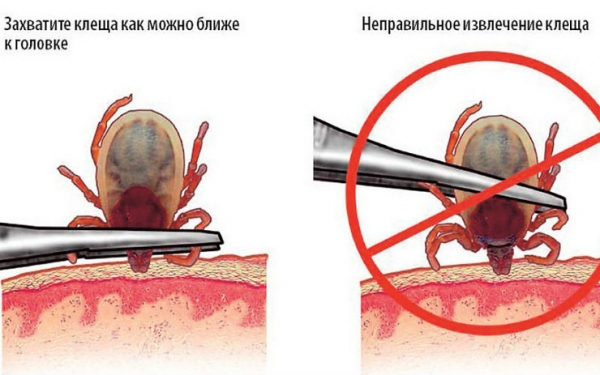 Walk in the woods or a city Park can result in serious disease. Infectious disease physician of the clinic of “Medicine” have made a few rules that must be followed. When heat finally I would like to throw tight clothes and solid shoes to walk barefoot on the grass and breathe in the scents of wildflowers. But, enjoying the colors of nature come alive, remember you are in the woods not alone!
Walk in the woods or a city Park can result in serious disease. Infectious disease physician of the clinic of “Medicine” have made a few rules that must be followed. When heat finally I would like to throw tight clothes and solid shoes to walk barefoot on the grass and breathe in the scents of wildflowers. But, enjoying the colors of nature come alive, remember you are in the woods not alone! 
Your movements watching a tick is a small creature that sits quietly swaying on the grass, waiting for his victim. Sensing a passing man or animal, he immediately rushes to the attack.
Claws and suction cups on the ends of the legs allow the mites cling securely to the clothing fabric or wool. Finding an open area of the body, it plunges its proboscis into the skin and cutting it reaches the subcutaneous blood vessels. To secure its place help him with the teeth on the mouth parts directed backward, and the first portion of saliva, which quickly solidifies and glues the tick to the skin like cement.
Meeting with the tick threat not only discomfort but also a risk of catching an infection. The worst of them – encephalitis and Lyme disease. They can permanently put you in the hospital. Surefire ways protect from infections – comply with the precautions and to prevent the attack of the parasite. To help protect yourself from seeing mites with an infectious disease doctor of the clinic “Medicine” Natalia Fedorova answer
9 naive questions
Ticks are only active in the summer?
Time activity of ticks has always been considered may-June and September-October. They love heat and humidity, but they do not like heat above +25 °C. during the day, the most active period – from the first dew before noon and in the evening from 16 o’clock till dark. In the autumn, when the temperature falls below +4 °C, the mites go dormant.
Ticks live in trees?
Although ticks and the animals of the forest, but the trees are not live and can not fly. The place of their dislocation – grass and litter formed by fallen leaves. Ticks are usually found in small-leaved and deciduous-coniferous forests, where there are birch, aspen, grey alder, bird cherry, Rowan, willow and pine and spruce. A lot of them usually ferns, elderberry and hazel. In pure coniferous forests mites are rare, they do not like and marshland, and soil covered with moss.
Ticks will attach themselves as soon as fall on the body?
Plants tick is placed so that the front pair of limbs free to stretch forward when approaching potential proximities. This so-called posture of waiting. When a tick is transplanted into the body of the victim, he can achieve his goal through 10 minutes, and can wander for hours in search of a suitable place. He is looking for, where he will be comfortable and warm. On the body it most often folds of skin under the knees, under the Breasts, in the crook of the elbow, between the buttocks, behind the ears, in the groin, where the skin is thin.
Mites have taste preferences?
It is a myth that is based on people’s observations: that some people clamp bite often and with pleasure, and the other bypassed. Scientists discovered that the bloodsucker may have a value of half the victims. Conducting research with a synthetic female and male pheromones, they found: ladies mite more attractive than men. Perhaps the reason is that women have thinner skin, which means that the parasite may quickly find a place to dig.
The tick bite always visible?
It’s not true. If females need to cling to the victim for a long time, up to 3-4 days, males just 25 minutes. During this time, bloodsucker works to replenish moisture, and then disappears. That’s why males are the most dangerous: they can feed without being noticed. At the same time, and females and males can be carriers of encephalitis and Lyme disease.
Do I need to water the stuck tick with vegetable oil?
I do not expect that this tick will come out himself. The saliva of the parasite threat, but no less dangerous contents of the intestine. And oil is likely to throw up. If the head is left inside the body, it will be visible as a small black dot. The only way to remove it is the standard method of pulling splinters – you need to repeatedly touch the foreign body with the tip of the needle.
If bitten by a tick, you will definitely get sick?
No need to panic! The saliva of the tick can indeed be a breeding ground for infections. The most common is Lyme disease, encephalitis, hemorrhagic fever. But not all ticks are carriers of germs. However, if there is a suspected bite, you must see a doctor and closely monitor their condition. Unfortunately, during the incubation period, which lasts 8-14 days, the disease can not manifest itself.
If you experience fever, headache and muscle pain, malaise, nausea and vomiting, rash, to the doctor you need to escape immediately! Initial consultation about the tick bite, please call an ambulance by telephone 103 (mobile – 112).
Is it possible to be vaccinated against all tick-borne infections?
Alas, it is impossible. The most common infection borreliosis (Lyme disease). From it there is no vaccine. Vaccination can only be done from the most dangerous infection – encephalitis. Immunity give two injections, administered for 3 months. In the future we will need more periodic injections to maintain the effect. If you start to get vaccinated now, then prepare the body for the autumn season of activity of ticks.
To ensure that the mite is not contagious, it is necessary to take the analysis?
You can, but keep in mind that the laboratory will accept only the living mites. Put it in a vial with wet cotton wool and keep in the fridge. If you are trying to extract, crushed the parasite, then the analysis you most likely will not accept. An exception is PCR diagnostics when you can bring even the remnants of the tick.
HOW TO REMOVE A TICK:

1. To do better with gloves to prevent the spread of harmful bacteria on your hands (they can enter the blood through the cracks).
2. Dampen a cotton ball with alcohol and gently wipe the skin around the tick without touching him.
3. Grab the tick with tweezers as close to the skin, being careful not to tear off the head or other parts of the body.
4. Pull upward gently and carefully remove the insect. Twisting or turning movements will not facilitate the removal, as mouthparts have barbs. Such actions may break off the head, increasing the risk of infection.
5. Wash the area of bite with soap and water or wipe with a weak disinfectant.
TAKE CARE OF PETS
Dogs and cats do not get sick with encephalitis and borreliosis. But that doesn’t mean tick season is safe for them. Ticks carry another dangerous disease, piroplasmosis. The most obvious sign of the fact that four-legged friend is sick, is a darkening of the urine color of strong tea or coffee. In pharmacies and pet stores has a large selection of various tools, deterring ticks.
They come in the form of sprays, collars and drops on the withers. Do not be lazy every night to see the pet. In case of detection remove the tick in the same way that humans. Other preventive means of prevention of infection with piroplasmosis does not exist: to date, not been invented yet no vaccine or serum (immunoglobulin) against this disease. By the way, dogs are infected with ticks more often than cats. And one tick can reward the animal with several diseases.